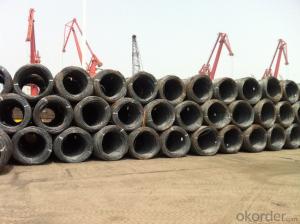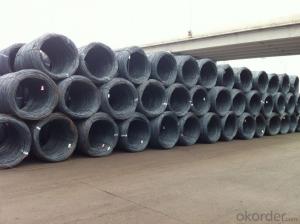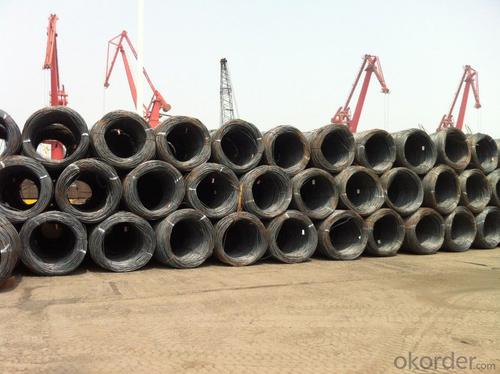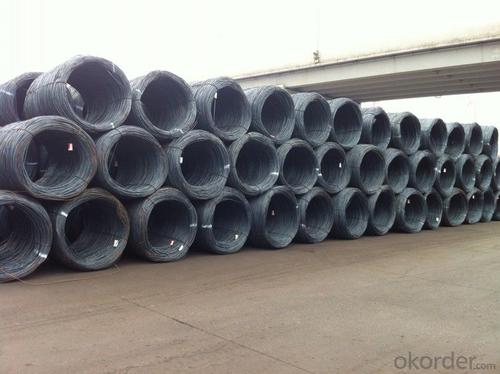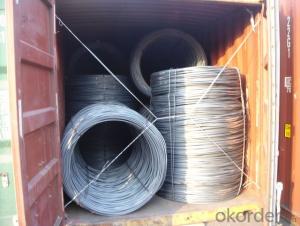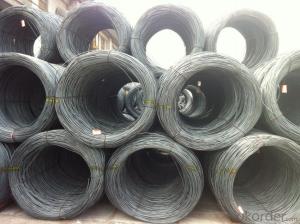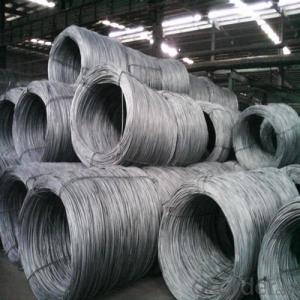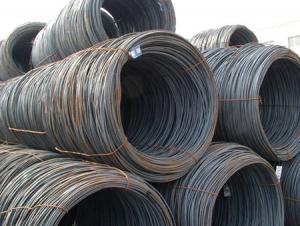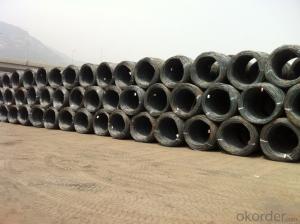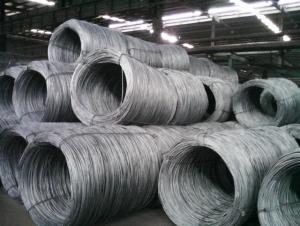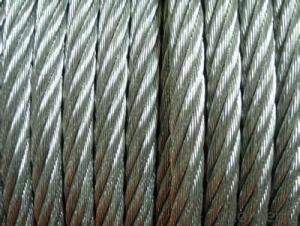SAE1008 Wire Rods Best Quality and Lowest Price
- Loading Port:
- Tianjin
- Payment Terms:
- TT OR LC
- Min Order Qty:
- 26 m.t.
- Supply Capability:
- 20000 m.t./month
OKorder Service Pledge
OKorder Financial Service
You Might Also Like
Specification
Grade: SAE1008 Standard: ASTM
Diameter: 5.5mm, 6.5mm, 7mm, 8mm, 9mm, 10mm, 11mm, 12mm
Alloy or Not: Alloy
Technique: Hot Rolled Place of Origin: China Mainland
Chemical Composition:
Please kindly find our chemistry of our material based on SAE1008 as below for your reference:
Grade | Chemical Composition (%) | |||||
C | Mn | S | P | Si | B | |
SAE1008 | 0.10max | 0.30-0.50 | 0.050max | 0.040max | 0.30max | 0.0008min |
Mechanical properties | ||||||
Yield strength(N/mm2) | Tensile strength(N/mm2) | Elongation (%) | ||||
≥195 | 350-380 | ≥32 | ||||
Usage and Applications of Wire Rod:
After hot-rolled the products shaped into coil and delivery as finished product, including round, square,rectangular, hexagonal and so on. Since most of the products are round, it is generally called wire rod. Carbon steel wire rod is widely used in construction and manufacturing. Carbon steel wire rod is mainly used for reinforcement of reinforced concrete and welded structure or reprocessed (roberts , nail, etc.) materials, especially used to produce wire drawing, welding electrode, nails, spring, electronic, precise machinery parts and so on.
Packaging & Delivery of Wire Rod:
Packaging Detail: products are packed in coil and then shipped by container or bulk vessel
Each coil weight: About 2.05MT
Delivery Detail: within 45 days after received deposit or LC.
Label: to be specified by customer, generally, each bundle has 1-2 labels
Trade terms: FOB, CFR, CIF
FAQ:
Q1: Why buy Materials & Equipment from OKorder.com?
A1: All products offered by OKorder.com are carefully selected from China's most reliable manufacturing enterprises. Through its ISO certifications, OKorder.com adheres to the highest standards and a commitment to supply chain safety and customer satisfaction.
A2: We have established an advanced quality management system which conducts strict quality tests at every step, from raw materials to the final product. At the same time, we provide extensive follow-up service assurances as required.
Q3: How soon we can delivery the goods ?
A3: We have a mill with 20000mts of capacity per month. We can delivery the goods within in one month ,as long as your order quantity less than 20000mts
Images of Wire Rod
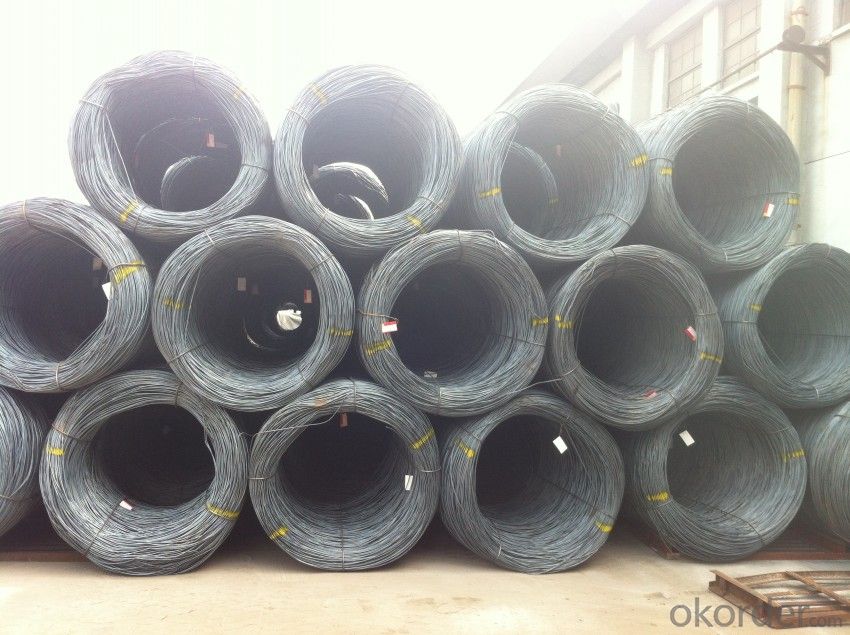
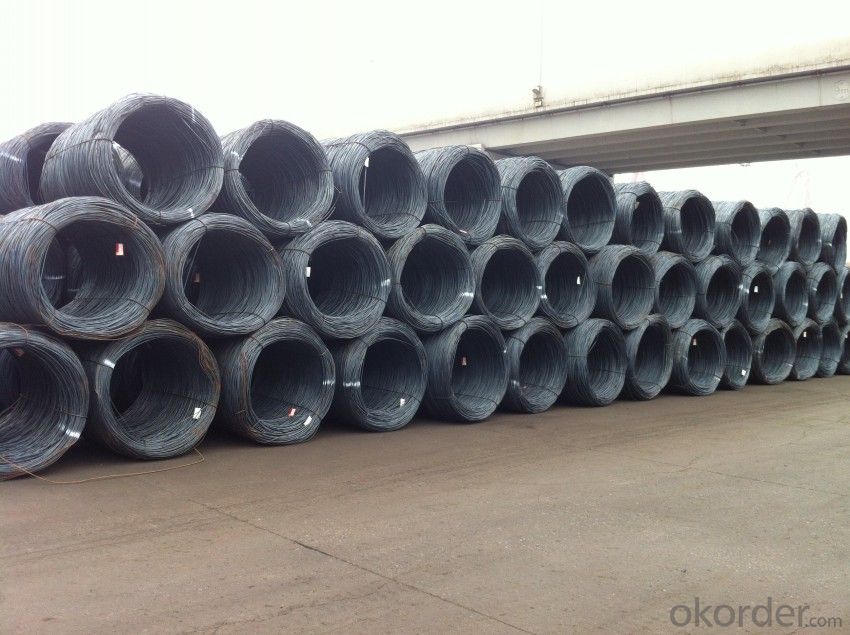
- Q: What are the different types of corrosion resistance tests conducted on steel wire rod?
- There are several types of corrosion resistance tests conducted on steel wire rods, including salt spray testing, cyclic corrosion testing, atmospheric exposure testing, electrochemical testing, and accelerated corrosion testing. These tests aim to simulate different environmental conditions and assess the ability of the steel wire rod to withstand corrosion in various settings.
- Q: How is steel wire rod used in the manufacturing of wire rope connectors?
- Steel wire rod is used in the manufacturing of wire rope connectors as it serves as the base material to create the connectors. The wire rod is first drawn into a thinner wire to form the strands of the wire rope. These strands are then twisted or braided together to create the wire rope. The wire rope connectors are then attached to the ends of the wire rope to provide a secure connection. Thus, steel wire rod plays a crucial role in the manufacturing process of wire rope connectors.
- Q: What are the different inclusion testing methods for steel wire rod?
- Steel wire rod commonly undergoes several different inclusion testing methods to detect and analyze non-metallic impurities that can affect its quality and performance. One method frequently used is microscopic examination. This involves taking a sample of the wire rod and preparing it for examination under a microscope. The sample is typically polished and etched to enhance visibility. By observing the size, shape, and distribution of the inclusions, they can be identified and characterized. Another widely employed inclusion testing method is ultrasonic testing. This technique employs high-frequency sound waves to detect and analyze inclusions in the wire rod. The waves pass through the material, and any disturbances caused by inclusions are detected and analyzed. This method provides information about the size, location, and type of inclusions present. In addition to these methods, more advanced techniques are available for inclusion testing. These include scanning electron microscopy (SEM), energy-dispersive X-ray spectroscopy (EDS), and X-ray diffraction (XRD). SEM allows for highly detailed imaging of inclusions, while EDS provides elemental analysis. XRD is used to determine the crystallographic structure of the inclusions. The choice of inclusion testing method depends on several factors, such as required accuracy, the specific type of inclusions of interest, and available equipment and expertise. Each method has its own advantages and limitations, so it is often advantageous to use a combination of techniques to gain a comprehensive understanding of the inclusions in steel wire rod.
- Q: What are the chemical properties of steel wire rod?
- The chemical properties of steel wire rod can vary depending on the specific composition of the steel. However, in general, steel wire rod is primarily made up of iron and carbon, with trace amounts of other elements such as manganese, silicon, and sulfur. The carbon content in steel wire rod plays a crucial role in determining its properties. Low carbon steel wire rod, which contains less than 0.25% carbon, is known for its ductility and ease of forming. This type of steel is commonly used in applications where flexibility and ease of manipulation are important, such as in the manufacturing of wire products, nails, and screws. On the other hand, high carbon steel wire rod, with carbon content ranging from 0.60% to 0.85%, is characterized by its strength and hardness. This type of steel is often used in applications that require high tensile strength and resistance to wear, such as in the production of springs, cables, and piano wires. Manganese is another element commonly found in steel wire rod. It is added to enhance the strength and hardenability of the steel. Manganese also improves the steel's resistance to corrosion and promotes the formation of a fine-grained microstructure, which contributes to its overall toughness. Silicon is often present in steel wire rod as a deoxidizing agent. It helps remove any impurities from the steel during the manufacturing process and improves its ability to withstand high temperatures without deformation. Sulfur is a trace element that is typically controlled in steel wire rod production. Its presence can have a detrimental effect on the steel's ductility and toughness, therefore, it is usually kept at low levels to ensure the desired mechanical properties of the wire rod. In summary, the chemical properties of steel wire rod are determined by its composition, with the carbon content being the most significant factor. Other elements such as manganese, silicon, and sulfur are also present in varying amounts and contribute to the steel's strength, hardness, ductility, and resistance to corrosion.
- Q: What is the average diameter of steel wire rod?
- The average diameter of steel wire rod varies depending on its intended application and industry standards. However, it typically ranges from 5.5 millimeters to 14 millimeters.
- Q: What are the standard straightness requirements for steel wire rod?
- The standard straightness requirements for steel wire rod typically specify that the wire rod should be straight within a certain tolerance limit, which is usually expressed as a maximum deviation from a straight line over a specified length. These requirements ensure that the wire rod is suitable for further processing and for its intended applications.
- Q: How is steel wire rod used in the manufacturing of wire for shopping carts?
- The manufacturing of wire for shopping carts relies heavily on steel wire rod. This component is essential as it undergoes a transformation into the wire used for constructing the cart's frame and handle. To initiate the manufacturing process, careful selection of steel wire rod is carried out based on its specific composition and quality. The rod is then subjected to heating and passed through a series of dies to gradually reduce its diameter and shape it according to the desired wire thickness. This process, known as drawing, guarantees that the wire attains the necessary strength and flexibility required for shopping cart construction. Once the wire is obtained, further processing takes place to eliminate any impurities and contaminants. Cleaning, pickling, and coating are some of the processes utilized to enhance the wire's durability and resistance to corrosion. These treatments are crucial in ensuring that the wire can withstand the daily wear and tear experienced by shopping carts. The wire is then fed into specialized machines that perform tasks such as bending, cutting, and welding to create the various components of the shopping cart. The wire is shaped to form the main frame structure, handle, and other necessary parts. These components are meticulously assembled, often with the incorporation of additional materials like plastic or rubber, resulting in a robust and functional shopping cart. The utilization of steel wire rod in the manufacturing of wire for shopping carts offers several advantages. Firstly, steel is a strong and durable material, making it ideal for supporting heavy loads and enduring constant use. Moreover, steel wire is highly resistant to bending and breaking, ensuring the long-lasting performance of shopping carts. In conclusion, the importance of steel wire rod in the manufacturing of wire for shopping carts cannot be overstated. It serves as the raw material that undergoes various processes like drawing, cleaning, and coating to produce the wire used in constructing the cart. The resulting wire is then shaped and assembled to create the different components, providing strength, durability, and reliability to the shopping cart.
- Q: What are the different forming processes used for steel wire rod?
- There are several forming processes used for steel wire rod, including hot rolling, cold drawing, and extrusion. Hot rolling involves heating the steel rod and passing it through a series of rollers to reduce its diameter and increase its length. Cold drawing, on the other hand, involves pulling the steel rod through a die to achieve the desired size and shape. Extrusion involves forcing the steel rod through a shaped die to create a specific cross-sectional profile. These forming processes are used to manufacture steel wire rods for various applications in industries such as construction, automotive, and manufacturing.
- Q: What are the different surface defects that can affect the ductility of steel wire rod?
- Some of the different surface defects that can affect the ductility of steel wire rod include cracks, scratches, pits, and scale. These defects can weaken the structure of the wire rod and reduce its ability to stretch or deform without breaking.
- Q: How is steel wire rod used in the manufacturing of pre-stressed concrete?
- Steel wire rod is an essential component in the manufacturing of pre-stressed concrete. Pre-stressed concrete is a type of concrete that has been reinforced with steel cables or bars to enhance its structural strength and durability. Steel wire rod is commonly used as the primary material for producing these steel cables or bars. In the manufacturing process, steel wire rods are first drawn through a series of dies to reduce their diameter and increase their tensile strength. This process, known as cold drawing, results in a smooth and consistent wire with a high strength-to-weight ratio. The wire rod is then wound into coils for easy handling and transportation. To create pre-stressed concrete, the steel wire rod is further processed into strands or individual wires. These strands or wires are then embedded into the concrete structure before it sets. The steel wires are tensioned using hydraulic jacks, applying a force that is greater than the anticipated load the concrete will experience during its service life. This tensioning process helps to counteract the tensile stresses that concrete naturally experiences, making it more resistant to cracking and deformation. By incorporating steel wire rods into pre-stressed concrete, the overall strength and durability of the structure are significantly improved. The steel wires act as a reinforcement, providing additional strength to the concrete and allowing it to withstand higher loads and resist cracking. This is particularly useful in applications such as bridges, buildings, and other infrastructure projects where the concrete needs to bear heavy loads or endure challenging environmental conditions. Furthermore, pre-stressed concrete structures are more cost-effective compared to traditional reinforced concrete. The use of steel wire rod reduces the need for additional reinforcement, such as steel bars, resulting in a lighter and more efficient structure. The reduced weight also facilitates faster construction and lower transportation costs. In conclusion, steel wire rod plays a crucial role in the manufacturing of pre-stressed concrete. It is used to create steel cables or bars that are embedded in the concrete structure, enhancing its strength, durability, and load-bearing capacity. By incorporating steel wire rods, pre-stressed concrete structures can withstand higher loads, resist cracking, and provide cost-effective solutions for various construction projects.
Send your message to us
SAE1008 Wire Rods Best Quality and Lowest Price
- Loading Port:
- Tianjin
- Payment Terms:
- TT OR LC
- Min Order Qty:
- 26 m.t.
- Supply Capability:
- 20000 m.t./month
OKorder Service Pledge
OKorder Financial Service
Similar products
Hot products
Hot Searches
Related keywords
